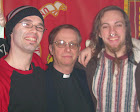
London to Brighton (2006) is Paul Andrew Williams' brilliant noir thriller. It revels in the low, violent, gritty underside of London, and is unrelentingly dark, in the manner of the kitchen sink films of the sixties. It also evokes Philip Saville's The Fruit Machine (1988), but with considerably less gay content. The mood of the two films is very similar, and the plot device of pursuit by brutal thugs, the same.
The main characters in London to Brighton all appear to be straight, and peformatively, they are, but there are sufficient suggestions of Foucault's manifold resistances to wonder. Can we indeed, as William Butler Yeats asks in Among School Children, "O body swayed to music, O brightening glance, How can we know the dancer from the dance?"
Is Stuart a closetted gay man? In many ways, this is implied. His fastidiousness in dealing with Derek's street world is suggestive, as is his reminiscence of his father's brutality and abuse. When he lights up a cigarette with Joann, it seems almost a celebration, a coming out, an emergence of new opportunities for him. The final reversal, where he chooses to protect Kelly and Joann, and instead kills Derek and Chum, their pursuers and tormentors reveals a sense of justice that seems outside the bounds of heterosexual behaviours. It is an affirmation of his freedom from his father, and the opening of new and independent pathways.
What is exactly the relationship between Derek and Chum? Chum seems always to accede to Derek. Are they partners? Could this be why Stuart kills him first? Do Kelly and Tracey have some sort of inimate past?
Hetero-normative sexuality is never portrayed in complementary terms. Straight sex is commodified, perfunctory, unpleasant, dangerous, and even fatal.
Although it certainly does not appear so on its surface, and was very likely not intended as such, London to Brighton is a very queer film indeed. 'Ere's to the Queen, God Bless 'Im.

No comments:
Post a Comment